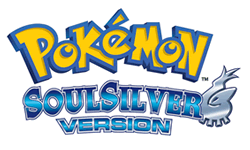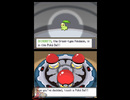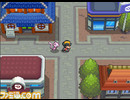|
|

|
PLATFORM
|
DS
|
BATTLE SYSTEM
|

|
INTERACTION
|

|
ORIGINALITY
|

|
STORY
|

|
MUSIC & SOUND
|

|
VISUALS
|

|
CHALLENGE
|
Moderate
|
COMPLETION TIME
|
60-80 Hours
|
|
OVERALL

|
+ Adds the improved, modern Pokémon battle system to a popular classic game
+ Excellent touch-screen interface improvements
+ Tons of activities and a huge supply of available Pokémon
- Kanto region isn't designed as well as Johto
- Sound isn't particularly good
|
Click here for scoring definitions
|
|
|
The Pokémon series is often the target of derision from so-called serious role-playing gamers, but many adults who have given the series a try have discovered a surprisingly deep combat system combined with an addictive collecting formula. I'm one of these adults, and have even brought my originally-reluctant spouse on board to enjoy the games and trade Pokémon with me. Being a recent convert to the series, I'd never played the original second-generation Pokémon games, Pokémon Gold/Silver. When Game Freak remade those games as Pokémon HeartGold and SoulSilver, I picked up SoulSilver to give it a spin.
For readers who dislike the basic gameplay and storyline found in the main Pokémon series, there is nothing new here. SoulSilver, as a remake, does not change that formula of playing a young Pokémon trainer who battles through a series of cities in order to become the best. However, it does provide a plethora of additions and tweaks that position it as a solid Pokémon game and a nice bridge between the fourth and fifth Pokémon generations. As my fellow staffer Zach Welhouse provided a helpful review for gamers who haven't played Pokémon before or who haven't played for a long time, this review will be more helpful to players who have enjoyed the recent Pokémon games and are wondering what new experiences SoulSilver provides.
The first thing a veteran Pokémon player will notice when starting SoulSilver is the new touchscreen menu system. The touchscreen menu is well-designed and makes menu features very accessible for players who enjoy using the stylus. It also expands the registered key items (items such as the bicycle and fishing rod that can be used with a single button press) from one to two and provides an auto-run button on the main menu screen. Inventory items in the player's bag are displayed with colourful icons, making them easier to quickly identify. In fact, all of the game's text and information has been sharpened and made easier to read.
There are still some unfortunate interface elements, however. While the player's inventory is divided into different categories, the items within each category cannot be sorted. The largest inventory categories quickly become cluttered, and due to the images, there aren't very many items on a single inventory page. Finding a specific item can involve a great deal of flipping through inventory pages. Similarly, the redesign of the Pokémon storage system has some good and bad points. Pokémon can now be dragged into storage boxes, which is handy, but the overall box redesign lacks support for button presses and remains a bit unwieldy.
 Weird little green thing, I choose you!
Weird little green thing, I choose you!
|
|
SoulSilver, like all main series Pokémon games, has a bare-bones story centered around the player character's quest to become a great Pokémon trainer. Really, the game doesn't progress through a story so much as present a sandbox world full of Pokémon-related activities that open up as the player overcomes various challenges and obstacles. Pokémon SoulSilver presents the player with two overarching goals: to complete an index of all the Pokémon in the Johto region (the game's setting) by catching and raising them, and to become a master Pokémon trainer by defeating the greatest Pokémon trainers in the Pokémon League. There's also a side story involving the player's opposition to the evil Team Rocket. Team Rocket is quite mean in this game, abusing Pokémon in rather nasty ways. It's satisfying to defeat them and ruin their plans, but unfortunately they only appear in a few sections of the game. Most of Johto is relatively Rocket-free, diminishing any sense of danger or menace.
Once the player has completed the challenges in the Johto area, they are able to move on to Kanto, the setting from Pokémon Red/Blue. Three years have passed since the events of Red/Blue, and there have been a few changes to Kanto. Unfortunately, the design and pacing of the Kanto section of the game is a bit of a mess, with no clear goal besides "defeat more gyms" and without clear directions on how to progress through the region. The small amount of story that was found in Johto is almost completely absent from Kanto, making the area a bit of a bore. NPC trainers and gym leaders in Kanto have been levelled up to provide an appropriate challenge to the player's team, but wild Pokémon remain at the same low levels they had in Red/Blue, which is both anticlimactic and frustrating. Overall, the Kanto region underscores the Pokémon series' weaknesses, and doesn't provide enough of its strengths to be much more than a slog towards the post-game activities.
With such a minimal storyline, the main focus in all the main Pokémon games is on fighting battles. The battle system in SoulSilver is basically identical to that found in other Generation IV Pokémon games. Every Pokémon must choose four moves from its available moveset (the moves that it learns as it levels up or inherits from its parents), and battle success depends on using Pokémon and moves of various types in an elaborate elemental rock-paper-scissors system. Water moves are highly effective against fire Pokémon, while electric moves will fry a water Pokémon to a crisp, etc. However, that system has been deepened over the years with the addition of features such as different attack types (physical or special), Pokémon with multiple elemental types, and moves that help players enhance a Pokémon's strength or cover its weaknesses.
The challenge provided by NPC Pokémon trainers seems to have been improved in SoulSilver. The more difficult enemy battles often feature Pokémon with unusual elemental combinations or well-chosen movesets. The two final challenges in the game, beating the Elite Four after completing Kanto and challenging the most powerful trainer ever seen in a Pokémon game, force the player to pit their Pokémon against foes of a much higher level than they likely obtained during their playthrough. This can be a nice challenge for players who choose to fight strategically rather than grind for levels. For advanced Pokémon players, defeating these final challenges gives the player full access to all the post-game features and the ability to catch all the Pokémon available in the game. SoulSilver retains the system of hidden statistics (IVs and EVs) that allow players to truly min-max their Pokémon and compete in competitive on-line battles, so there is no good news for players who hope that the advanced game will become more transparent.
 Walking with your Pokémon is a nice little addition.
Walking with your Pokémon is a nice little addition.
|
|
Beyond battling, SoulSilver contains a plethora of activities and diversions to entertain the player. Many of them are dedicated to catching or receiving new Pokémon, as a major portion of the entire Pokémon catalog is available for capture in SoulSilver. There is a bug catching contest in the National Park, and the Game Corner in Johto's largest city contains Voltorb Flip, an addictive minigame that's sort of a combination of Sudoku and Minesweeper. There's the Pokéathon, a minigame-fest that is one way to earn items needed to evolve Pokémon to more powerful forms. The quality of the minigames is variable, ranging from fun to frustrating, but the Pokéathon is fully optional and is generally an improvement over Diamond/Pearl's Pokémon contests. The Safari Zone, an area in which players hunt rare Pokémon, has been greatly improved from previous versions. Players are able to arrange and landscape the Safari Zone's various ecosystems in order to attract different Pokémon, and there is no longer a step or time limit for adventuring in the Zone.
Finally, there's the Pokéwalker, a pack-in pedometer that connects with the SoulSilver cartridge and allows players to "stroll" with a Pokémon in real life. Building up steps on the Pokéwalker can help a player level a Pokémon, make it happier, and catch wild Pokémon or hunt for items in very simple minigames. It's fun, but it could have been designed better to encourage more use. A Pokémon can only level up once per trip and doesn't learn any moves or evolve if it levels up in the Pokéwalker. Also, the Pokéwalker can't hatch eggs, which would have been a great option to make a tedious portion of the main game more fun.
SoulSilver retains the same visual style as Pokémon Diamond/Pearl, but has improved the graphics in several ways. Many of Johto's cities have a nice individual style, with enhancements such as glowing lanterns or seaside decor. Kanto doesn't fare as well with the visual makeover, with a few of its color-themed cities such as Saffron looking downright ugly. The Pokémon themselves come out well in SoulSilver's graphical tweaks. They have all been modeled in-game, because the lead Pokémon follows the player's character around, and it's fun to take out the different Pokémon to see how they look and move. Battle sprites and animations have been improved as well, emphasizing the personalities of various Pokémon species. The adorable Ampharos smiles and waves at opponents, while the poison Pokémon Weezing blearily exhales like a 15-pack-a-day smoker. Overall, although the graphic style of the game isn't for everyone, the graphics are some of the most detailed available on the DS without sacrificing clarity.
The sound in SoulSilver doesn't fare as well as its graphics. Most of the music isn't terribly memorable, and sounds cheap and tinny even through headphones. The quality of the Pokémon cries is variable, as well. More recent Pokémon sound much nicer than their older brethren, who appear to be stuck with ancient sound files. The one nice sound touch that SoulSilver adds is a few environmental sounds, like footsteps and water.
It would be remiss not to mention the multiplayer system, which is the main focus of the Pokémon franchise for many of its fans. For better or worse, SoulSilver's multiplayer features are virtually unchanged from Diamond/Pearl. This allows SoulSilver owners to battle and trade with Diamond/Pearl/Platinum owners, but retains the cumbersome Pal Pad/friend code system. Trades still take an extremely long time and force players to watch an extended animation with every trade. Here's hoping that the multiplayer features can be streamlined and opened up a bit with the next Pokémon game generation.
Overall, Pokémon SoulSilver is an excellent remake that adds the innovations of newer Pokémon games to a popular older game region. Although the Kanto region of the game could have used more attention, SoulSilver contains an extensive amount of gameplay. It's a multifaceted Pokémon playground that provides a little something for every kind of player. It comes highly recommended for existing fans of the series, and would be a good choice for gamers who are interested in trying Pokémon for the first time.
Review Archives
|









